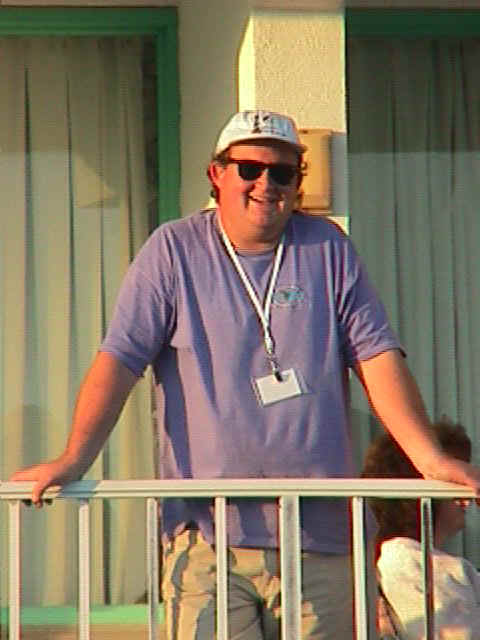School’s Back In Session
 Welcome back to class. I hope everyone is practicing precision, having fun, and planning to attend the AKA Nationals next fall. There are times when developing my column that I feel as though I am repeating myself, but new readers are attracted to the ‘zine all the time and they should get some hints on competing in Novice Class. This issue I’ll be discussing the basics of Novice Ballet and Novice Precision and hopefully provide you – the novice competitor – with some hints that can lead to higher scores. For those who regularly visit my class, there are a few new ideas in this session that you may find helpful. I guess I’ll call this month’s article…..Phil’s Second Annual Novice Competitor Warm-up.
Welcome back to class. I hope everyone is practicing precision, having fun, and planning to attend the AKA Nationals next fall. There are times when developing my column that I feel as though I am repeating myself, but new readers are attracted to the ‘zine all the time and they should get some hints on competing in Novice Class. This issue I’ll be discussing the basics of Novice Ballet and Novice Precision and hopefully provide you – the novice competitor – with some hints that can lead to higher scores. For those who regularly visit my class, there are a few new ideas in this session that you may find helpful. I guess I’ll call this month’s article…..Phil’s Second Annual Novice Competitor Warm-up.
Be Prepared
Your materials for this class will include the book “Stunt Kite Basics” by Richard Synergy, the AKA Sport Kite Rules book – both the 4th edition and the International Rules Update, a few kites, some good quality line (I recommend Blue Line ES55), and the Prism Video – The Advanced Way to Fly, and a place to fly your kite.
For those of you who don’t own the “Stunt Kite Basics” book or the “Sport Kite Magic” book by Dave Gomberg – you should own at least one of them. I feel the MOST important sections (to novice competitors) discuss each precision figure and detail hand movements and body movements of the kite flier. These books will help you fly better precision.
The AKA Rules books are available from the AKA web site. Download them and have a copy of each figure available when you are practicing. Make it your goal to memorize the first 15 figures in the book. Figures 1 through 15 are usually the figures that novice competitors are asked to fly. However, every once in a while, an event organizer will have a higher number figure for the novices to fly – so be prepared. Organizers are asked to publish the precision figures in advance, so you should have plenty of time to familiarize yourself with the figures at a given event.
If you have not done so already, study every videotape you can get your hands on. I have quite a little collection of event videos, as well as many commercial videos. I have the complete Dodd Gross series and Prism series of videos and have learned something from each one. Although I encourage you to build your own video library with each of these, I can say that the Prism “Advanced Way to Fly” is a great video if you want to learn how to do some “stuff”, and know how to assemble your kite and keep it under control. The Advanced Way to Fly has GREAT instruction on Stalls, Side Slides, Flat Spins and Axles. For basic flight skills, I’d have to recommend Dodd Gross’ Flight School 1.5. Although I’m still partial to the original Flight School video with Dodd discussing kite flying in what appears to be a restaurant of some type, Flight School 1.5 is a GREAT Beginner video and I highly recommend it.
Finally, get yourself some good quality Spectra line to fly on. I recommend Blue Line ES/55 line. It is without a doubt, the best line on the market. Get yourself a couple of sets of Blue Line ES/55, put your other lines away for a month or so and use only the ES/55. I don’t think you’ll ever want to fly on your old line sets again.
The Competition
As a novice flier, you can compete in either Novice Precision, Novice Ballet or both. I recommend competing in both. Personally, ballet is the most fun for me and precision is the most difficult. However, precision is the name of the game. The ability to place your kite in the sky where you want is critical to anything else you might want to do as a kite flier. I’m thinking primarily of pairs or team flying, but the skill is also useful in ballet.
Novice Precision
I recently asked this question to a group of Masters Class kite fliers. What is the single most important thing that the novice competitor can do to improve their skills and competition scores?
Their response was: Practice Precision. (Judging was a close second!)
Your ability to control the kite, not bobble corners, and minimize oversteer are all a function of your precision skills. The things you HAVE to do to fly good precision will make you a better flier. Flying good precision means you have to know how to use your body to maintain speed control. There is a great discussion of body movement in the Synergy book. Speed Control is one of the factors judges look at when judging precision. SO, it would make sense to be flying a kite that has a relatively constant forward speed, handles gusts well, and doesn’t get too fast.
If you have the ability to videotape your practice sessions, you can see where you make common mistakes and can work on eliminating them. All you really need is a video camera and a tripod. Position the video camera 50-75 feet behind you and point it in the direction of your wind window and videotape your flying. This way you can be your own judge! If this is not an option for you, then you should at least have a friend judge your figures and tell you if your proportions are off. I think that the figure proportions are the most difficult thing for ANY competitor to master.
The 3 figures that novice’s are usually assigned makes up a majority of your precision score. However, the freestyle section makes up 40% of your total score (30% technical and 10% artistic) and can significantly improve or reduce your score. This component is where you get to show the judges your “stuff”. It is where you could throw in a trick or two if you want. I like tricks… let me rephrase that, I love tricks. I think that competitors are far too cautious and don’t take enough chances and often end up with boring routines. HOWEVER, precision is not the place for a lot of tricks. Precision freestyle is where you get to demonstrate flow and control. Pick figures that flow into one another….. here’s an example novice precision freestyle routine.
Sample Precision Freestyle Routine
Launch in the Center of the window and climb straight up.
Snap a left turn at the top of the window (setting up for square)
Figure #2 Square
You’ll exit the square on the left side of the window and can turn down and immediately go into an Infinity Down #1
Exiting the Infinity Down in mid window, go up to the top center of the window and enter a Power Dive with Roll #10.
Exiting the power dive with roll at the top of the window, go to the left side of the window and set up to enter the Pyramid #8
After the pyramid, exit to the right side of the window, execute a down turn and set up for a low ground pass from right to left (low ground passes close to the ground demonstrate control!)
You could stall and axle when you got to the left edge, and immediately start a low ground pass from left to right (here you could do a jump #4 or bulb #9 instead of a low ground pass)….
When you get to the right side of the window you could turn up, climb to the top and immediately go into a Steps Down #13 – Landing on the left edge when finished.
This routine has flow. It has a plan. Once you complete a figure, you immediately start something else. There is no flying aimlessly about and looking/remembering what to do next. There was some thought into the routine and that will help your scores. Tricks will not help you a great deal…but if you have to do them to be happy, remember not to overdo it with too many tricks and place them appropriately.
Other things mentioned in earlier columns which can improve your novice precision scores include: Use longer lines, 100 ft minimum up to 130 – 140 feet. Choose an appropriate kite. Do not walk on to the precision field with a 6ft trick kite. Use a big slow “team” kite which will give you more chance to react and have a more constant speed.
Novice Ballet
Your Ballet scores can improve with better precision and control. However, good music selection is CRITICAL to a good ballet score. Your music must provide you with the opportunities to have your kite match or move when the music does something. Do NOT pick music that is too fast. I would recommend you pick a fairly slow piece of music with highs and lows, fasts and slows… Movie themes seem to possess these qualities although I’m quite sick of hearing them at events, they have the qualities to build a good routine around and are easy to understand and judge. DO NOT pick the latest jazz fusion recording in 6/13 time… What I mean is….. pick music that is powerful and easy to understand. If it is difficult for one of your friends to understand, it is going to be difficult for judges to understand. Music that is too busy is very hard to judge.
The best advice I can give you for your Ballet routine would be to pick some music that has a place for you to land (the music fades out in the middle for a couple of seconds or stops abruptly for a couple of seconds). If the music is fading out you could go into a side slide as it is fading out and land just as it is silent. If it is an abrupt stop, you could do a tip stab or STALL and Land during the silence. Avoid the temptation to do a LOT of tricks, demonstrate a PLAN to the judges, tell them a story, take them on a ride. Watch the masters class competitors. One of my favorites is Scott Weider. Scott’s Dual Line Ballet is to powerful music and his routine just draws you in. The kite tells the tale of the music and takes you along for a short ride. It is hypnotic. However, each of you must find your own way and develop your own style. Most importantly pick music that you enjoy, and your routine will be better.
Wrap Up
I hope that each of you who is considering competition will choose to enter a competition this spring. After all, April is National Kite Month and it’s time to get more involved. You will find the competition field exciting, fun, rewarding, and a continual challenge. Each time you walk on the field to compete it is different. Sometimes it boils down to who made the right kite choice or who had the best wind. Perhaps I’ll get to meet you at the Smithsonian or MASKC in Ocean City at the end of April. Please look me up if you’re at one of these events, I look forward to meeting you.

